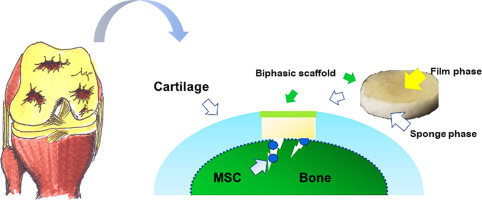当前位置:
X-MOL 学术
›
Mater. Des.
›
论文详情
Our official English website, www.x-mol.net, welcomes your feedback! (Note: you will need to create a separate account there.)
Biphasic scaffolds of silk fibroin film affixed to silk fibroin/chitosan sponge based on surgical design for cartilage defect in osteoarthritis
Materials & Design ( IF 8.4 ) Pub Date : 2018-03-01 , DOI: 10.1016/j.matdes.2018.01.006 Khanitta Panjapheree , Suttatip Kamonmattayakul , Jirut Meesane
Materials & Design ( IF 8.4 ) Pub Date : 2018-03-01 , DOI: 10.1016/j.matdes.2018.01.006 Khanitta Panjapheree , Suttatip Kamonmattayakul , Jirut Meesane

|
Abstract Osteoarthritis is inflammation that can occur at any joint, and is caused by cartilage degeneration. For severe cases, patients need surgery by substitution with performance tissue engineering scaffolds. Biphasic scaffolds of silk fibroin film affixed to a silk fibroin/chitosan sponge were constructed for osteoarthritis surgery. Silk fibroin film was fabricated before affixation to the sponge of silk fibroin/chitosan at different ratios of silk fibroin to chitosan: 100:0 (SF), 70:30 (SF70), 50:50 (SF50), 30:70 (SF30), and 0:100 (CS). The morphologies of the scaffolds were observed by scanning electron microscopy. Physical functionality as well as stability was evaluated from mechanical properties, and the percentage of swelling, and degradation. Biological functionality was evaluated using a rat mesenchymal stem cell (RMSCs) culture. Cell proliferation was analyzed and the histological structure was observed. SF30 showed suitable morphology, physical stability, and biological functionality to promote RMSC regulation into chondrocytes. This indicated that SF30 shows promise for cartilage regeneration in osteoarthritis surgery.
中文翻译:

基于手术设计的丝素蛋白膜双相支架固定在丝素蛋白/壳聚糖海绵上治疗骨关节炎软骨缺损
摘要 骨关节炎是一种可发生于任何关节的炎症,由软骨退变引起。对于严重的病例,患者需要用高性能组织工程支架替代手术。为骨关节炎手术构建了固定在丝素蛋白/壳聚糖海绵上的丝素蛋白膜的双相支架。以不同的丝素蛋白与壳聚糖的比例:100:0 (SF), 70:30 (SF70), 50:50 (SF50), 30:70 (SF30), 在将丝素蛋白/壳聚糖固定在海绵上之前制作丝素蛋白膜) 和 0:100 (CS)。通过扫描电子显微镜观察支架的形态。从机械性能、溶胀和降解百分比评估物理功能以及稳定性。使用大鼠间充质干细胞 (RMSC) 培养物评估生物功能。分析细胞增殖并观察组织学结构。SF30 显示出合适的形态、物理稳定性和生物学功能,以促进 RMSC 调节到软骨细胞中。这表明SF30在骨关节炎手术中显示出软骨再生的前景。
更新日期:2018-03-01
中文翻译:

基于手术设计的丝素蛋白膜双相支架固定在丝素蛋白/壳聚糖海绵上治疗骨关节炎软骨缺损
摘要 骨关节炎是一种可发生于任何关节的炎症,由软骨退变引起。对于严重的病例,患者需要用高性能组织工程支架替代手术。为骨关节炎手术构建了固定在丝素蛋白/壳聚糖海绵上的丝素蛋白膜的双相支架。以不同的丝素蛋白与壳聚糖的比例:100:0 (SF), 70:30 (SF70), 50:50 (SF50), 30:70 (SF30), 在将丝素蛋白/壳聚糖固定在海绵上之前制作丝素蛋白膜) 和 0:100 (CS)。通过扫描电子显微镜观察支架的形态。从机械性能、溶胀和降解百分比评估物理功能以及稳定性。使用大鼠间充质干细胞 (RMSC) 培养物评估生物功能。分析细胞增殖并观察组织学结构。SF30 显示出合适的形态、物理稳定性和生物学功能,以促进 RMSC 调节到软骨细胞中。这表明SF30在骨关节炎手术中显示出软骨再生的前景。


























 京公网安备 11010802027423号
京公网安备 11010802027423号